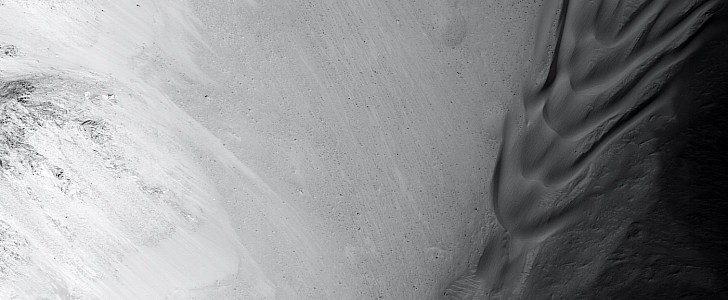Like it or not, humanity has reached a point where it can start dreaming of building cities on alien planets. Sure, humans have never actually been to such a place, but plans are in motion to allow humanity’s expansion into the solar system.
These days, the eyes of the world are affixed on the Artemis program. Although it is officially meant to put human boots on the Moon once more, Artemis will likely be the stepping stone for a yet unnamed effort to reach Mars.
Once there, we’ll probably spend a few decades exploring the place, and if everything is to our liking, settlements will spurt, centuries from now, on the surface of the Red Planet. Some of them might even be situated in the Coprates Chasma region of the planet, a place like no other on Mars, offering views of falling dunes.
These features, in fact nothing more than sand dunes “that formed when down-slope winds were focused by the gully topography,” are quite rare over on the neighboring planet, but rather abundant in eastern Coprates Chasma, a large canyon (966 km/600 miles long), part of the Valles Marineris system.
A HiRISE photo of the region, taken back in 2008 from an altitude of 258 km (160 miles), shows how these dunes tend to congregate to form intricate patterns that can be made by our brains to look like all sorts of things – in this case, the wake of a boat on a lake, or the spine of some long-extinct creature.
The image, released by NASA and the University of Arizona at the beginning of the year, shows an 8 km (5 miles) section of the Coprates Chasma, and, if you know what to look for, aside from the dunes, you also get the southern plateau, wall spurs, fans of eroded material, gullies, and the canyon floor.
Once there, we’ll probably spend a few decades exploring the place, and if everything is to our liking, settlements will spurt, centuries from now, on the surface of the Red Planet. Some of them might even be situated in the Coprates Chasma region of the planet, a place like no other on Mars, offering views of falling dunes.
These features, in fact nothing more than sand dunes “that formed when down-slope winds were focused by the gully topography,” are quite rare over on the neighboring planet, but rather abundant in eastern Coprates Chasma, a large canyon (966 km/600 miles long), part of the Valles Marineris system.
A HiRISE photo of the region, taken back in 2008 from an altitude of 258 km (160 miles), shows how these dunes tend to congregate to form intricate patterns that can be made by our brains to look like all sorts of things – in this case, the wake of a boat on a lake, or the spine of some long-extinct creature.
The image, released by NASA and the University of Arizona at the beginning of the year, shows an 8 km (5 miles) section of the Coprates Chasma, and, if you know what to look for, aside from the dunes, you also get the southern plateau, wall spurs, fans of eroded material, gullies, and the canyon floor.







